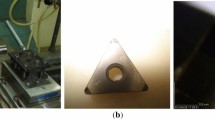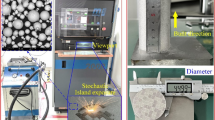Abstract
The presence of burrs in mechanical processing can negatively affect surface integrity and dimensional accuracy and even lead to part scrapping. Grain size also has a significant impact on material properties and subsequently generate different processing effects. However, only few studies have explored the effect of grain size on machined surface integrity and burr formation. To fill this gap, this study develops a model based on dislocation density and incorporates this model into ABAQUS using subroutines to investigate polycrystalline cutting modeling and the burr formation mechanism. In addition, the plastic flow and deformation process of grains are observed using a newly developed 2D polycrystalline model, which is later compared with traditional Johnson-Cook constitutive models. The simulated cutting force value, chip morphology, and experimental results are also compared to preliminarily validate the feasibility of the developed model. The experimental results remain consistent across different simulated cutting speeds and depths. The height and width of the exit burr slightly decrease along with increasing cutting speed. Meanwhile, increasing the cutting depth significantly increases the burr width and height. The lateral burrs observed in the experiment can also be reproduced using a 3D polycrystalline model. The lateral burr size increases along with cutting depth and speed. The effect of grain size on cutting force and burr formation is eventually explored, and results show that increasing the grain size reduces the cutting force but increases the burr size. This study provides a new concept for burr control and surface integrity improvement.
Similar content being viewed by others
References
A. Toropov, S. L. Ko and B. K. Kim, Experimental study of burrs formed in feed direction when turning aluminum alloy Al6061-T6, Int. J. Mach. Tool. Manu., 45 (9) (2005) 1015–1022.
D. I. Poór, N. Geier and C. Pereszlai, A critical review of the drilling of CFRP composites: burr formation, characterisation and challenges, Composites Part B: Engineering, 223 (2021) 109155.
S. Y. Jin, A. Pramanik and A. K. Basak, Burr formation and its treatments-a review, Int. J. Adv. Manuf. Tech., 107 (5) (2020) 2189–2210.
S. A. Niknam and V. Songmene, Milling burr formation, modeling and control: A review, Proceedings of the Institution of Mechanical Engineers, Part B: Journal of Engineering Manufacture, 229 (6) (2015) 893–909.
S. A. Niknam, B. Davoodi and J. P. Davim, Mechanical deburring and edge-finishing processes for aluminum parts-a review, Int. J. Adv. Manuf. Tech., 95 (1) (2018) 1101–1125.
L. K. Gillespie and P. T. Blotter, The formation and properties of machining burrs, ASME Journal of Engineering for Industry, 98 (1) (1976) 66–74.
L. K. Gillespie, The formation and properties of machining burrs, Master’s Thesis, Utah State University. Logan, Utah (1973) 4558.
S. Cedergren, S. Olovsjö and G. Sjöberg, The effects of grain size and feed rate on notch wear and burr formation in wrought Alloy 718, Int. J. Adv. Manuf. Tech., 67 (5) (2013) 1501–1507.
L. Zhong, L. Li, X. Wu, N. He, G. Zhao and C. Yao, Fabrication of PCD micro cutting tool and experimental investigation on machining of copper grating, Int. J. Adv. Manuf. Tech., 88 (9–12) (2016) 2417–2427.
L. K. Gillespie, Burrs Produced by End Milling, Bendix Corp. (1976).
Y. Zhu and G. Wang, Simulation model and mechanism of burr formation, 2008 International Workshop on Modelling, Simulation and Optimization, Hong Kong, China (2008) 350–354.
S. A. Niknam and V. Songmene, Modeling of burr thickness in milling of ductile materials, Int. J. Adv. Manuf. Tech., 66 (9–12) (2013) 2029–2039.
H. J. Qu, J. H. Yang and G. C. Wang, Simulation and control of two side direction burr, Applied Mechanics and Materials, Trans Tech Publications Ltd., 143 (2012) 428–432.
X. Wu, L. Li and N. He, Investigation on the burr formation mechanism in micro cutting, Precision Engineering, 47 (2017) 191–196.
M. Olsson, H. Persson and M. Agmell, FE simulation and experimental verification of side-flow and burr formation in machining of oxygen-free copper, Procedía CIRP, 72 (2018) 1427–1432.
K. Yang, Q. S. Bai and F. L. Yu, Modelling and experimental analysis of the mechanism of micro-burr formation and micro-end-milling process, Nanotechnology and Precision Engineering, 8 (1) (2010)75–83.
D. Huo and K. Cheng, Experimental investigation on micromilling of oxygen-free, high-conductivity copper using tungsten carbide, chemistry vapour deposition, and single-crystal diamond, Proceedings of the Institution of Mechanical Engineers, Part B: Journal of Engineering Manufacture, 224 (2010) 995–1003.
D. Biermann and M. Heilmann, Burr minimization strategies in machining operations, Proceedings of CIRP International Conference on Burrs—Analysis, Control and Removal, Kaiserlautern (2010) 13–20.
B. Denkena, T. Grove and H. Lucas, Influences of grinding with Toric CBN grinding tools on surface and subsurface of 1.3344 PM steel, Journal of Materials Processing Technology, 229 (2016) 541–548.
X. Yang, B. Zhang and Q. Bai, Effect of grain size on subsurface characterization of pure iron subjected to orthogonal cutting, Int. J. Adv. Manuf. Tech., 120 (2022) 5793–5806.
G. R. Johnson and W. H. Cook, A constitutive model and data for metals subjected to large strains, high strain rates and high temperatures, Proceedings of the 7th International Symposium on Ballistics, The Hague, Netherlands (1983) 541–547.
S. R. Bodner and Y. Partom, Constitutive equations for elastic-viscoplastic strain-hardening materials, J. Appl. Mech., 42 (2) (1975) 385–389.
Z. F. Zerilli and R. W. Annstrong, Dislocation-mechanics-based constitutive relations for material dynamics calculations, Appl. Phys., 61 (1987) 1816–1825.
P. S. Follansbee and U. F. Kocks, A constitutive description of the deformation of copper based on the use of the mechanical threshold stress as an internal state variable, Acta Metall, 36 (1) (1988) 81–93.
Y. Estrin, L. S. Tóth, A. Molinari and Y. Bréchet, A dislocation-based model for all hardening stages in large strain deformation, Acta Materialia, 46 (15) (1998) 5509–5522.
U. F. Kocks, Laws for work-hardening and low-tem-perature creep, Journal of Engineering Materials and Technology, 98 (1976) 76.
L. Vincent, Y. Estrin, H. S. Kim and R. O. Donnell, Grain refinement under high strain rate impact: A numerical approach, Computational Materials Science, 48 (1) (2009).
G. R. Johnson, A constitutive model and data for materials subjected to large strains, high strain rates, and high temperatures, Proceedings of the 7th International Symposium on Ballistics (1983) 541–547.
Z. Wang, J. Zhang, Z. Xu, J. Zhang, H. ul Hassan, G. Li, H. Zhang, A. Hartmaier, F. Fang, Y. Yan and T. Sun, Crystal plasticity finite element modeling and simulation of diamond cutting of polycrystalline copper, Journal of Manufacturing Processes, 38 (2019) 187–195.
C. Zhao and Y. B. Liu, The research on milling force in high-speed milling nickel-based superalloy of Inconel 718, Applied Mechanics and Materials, Trans Tech Publications Ltd., 395 (2013) 1031–1034.
H. P. Zhang, Q. Y. Zhang and Y. Ren, Simulation and experiments on cutting forces and cutting temperature in high speed milling of 300M steel under CMQL and dry conditions, International Journal of Precision Engineering and Manufacturing, 19 (8) (2018) 1245–1251.
Z. L. Zhong, X. Ai and Z. Q. Liu, Experimental study on cutting force and surface roughness for 7050-T7451 aluminum alloy of high speed milling, Applied Mechanics and Materials, Trans Tech Publications Ltd., 395 (2013) 1026–1030.
A. Vandana and N. K. Sundaram, Simulation of sinuous flow in metal cutting, Tribology Letters, 66 (3) (2018) 94.
A. S. Vandana and N. K. Sundaram, Simulation of machining of ductile polycrystalline aggregates using a remeshing framework, Journal of Manufacturing Processes, 54 (2020) 1–13.
A. Udupa, A. S. Vandana and M. Saei, Sinuous plastic flow: Mechanics, microstructural basis, and control, International Journal of Machine Tools and Manufacture, 168 (2021).
H. Liu, X. Xu, J. Zhang and Z. Liu, The state-of the-ar-ton numerical simulation of the effect of microstructure and its evolution in metal cutting processes, International Journal of Machine Tools and Manufacture (2022).
Y. Long and C. Guo, Finite element modeling of burr formation in orthogonal cutting, Machining Science and Technology, 16 (3) (2012) 321–336.
M. Asad, H. Ijaz and M. A. Khan, A numerical insight on machining burr formation: A comprehension to optimization approach, Materials Today: Proceedings, 33 (2020) 1792–1799.
W. J. Deng, W. Xia and Y. Tang, Finite element simulation for burr formation near the exit of orthogonal cutting, Int. J. Adv. Manuf. Tech., 43 (9) (2009) 1035–1045.
X. Xu, J. Outeiro and J. Zhang, Machining simulation of Ti6Al4V using coupled Eulerian-Lagrangian approach and a constitutive model considering the state of stress, Simulation Modelling Practice and Theory, 110 (2021) 102312.
J. D. Liu, W. Yuan and J. K. Xiong, Study on the two-side direction burr in grinding-hardening machine based on orthogonal experimental method, Applied Mechanics and Materials, Trans Tech Publications Ltd., 217 (2012) 1869–1873.
S. Gao, J. Liu and J. Jin, Orthogonal experimental study on two side-direction burrs of grind-hardening workpiece based on transverse feed, IOP Conference Series: Materials Science and Engineering, IOP Publishing, 542 (1) (2019) 012030.
H. Wang, J. Chen, C. Wang, G. Guoqiang, Q. An, W. Ming and M. Chen, Burr formation mechanism and morphological transformation critical conditions in grinding of nickel-based superalloy honeycomb cores, SSRN (2022) https://doi.org/10.2139/ssrn.4092487.
Y. Ayed, C. Robert and G. Germain, Orthogonal micro-cutting modeling of the Ti17 titanium alloy using the crystal plasticity theory, Finite Elements in Analysis and Design, 137 (2017) 43–55.
T. Komatsu, Y. Musha and T. Yoshino, Surface finish and affected layer in milling of fine crystal grained stainless steel, Journal of Manufacturing Processes, 19 (2015) 148–154.
X. Wu, L. Li and N. He, Investigation on the influence of material microstructure on cutting force and bur formation in the micro cutting of copper, Int. J. Adv. Manuf. Tech., 79 (1) (2015) 321–327.
Acknowledgments
This work was supported by the National Natural Science Foundation of China (Grant Nos. 51765009, 52265057 and 52165042), the Introduction of Talents Research Project of Guizhou University (2021-2021), and the Guizhou Provincial Science and Technology Projects [2020]1Y236, China.
Author information
Authors and Affiliations
Corresponding author
Additional information
Jiaxin Wen (1997-), Master of Engineering, mainly engaged in research areas: advanced tool technology, machining process physical simulation modeling, intelligent manufacturing. E-mail: wjx1297690972@foxmail.com.
Lin He (1965-), Doctor of Engineering and Professor of Ph.D., mainly engaged in research fields: tool design and manufacturing, advanced manufacturing and processing technology and equipment, tribology and high-performance friction material research. E-mail: helin6568@163.com.
Rights and permissions
About this article
Cite this article
Wen, J., He, L., Zhou, T. et al. Modeling of the polycrystalline cutting of austenitic stainless steel based on dislocation density theory and study of burr formation mechanism. J Mech Sci Technol 37, 2855–2870 (2023). https://doi.org/10.1007/s12206-023-0512-8
Received:
Revised:
Accepted:
Published:
Issue Date:
DOI: https://doi.org/10.1007/s12206-023-0512-8




